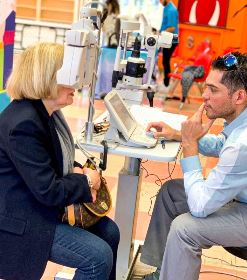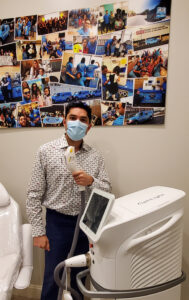
Dr. Mena seeing a patient in his mobile clinic, which allows him to bring eyecare to patients, rather than expecting them to always be able to come to him.
By Vittorio Mena, OD, MS
May 24, 2023
Modern patients want easy access to everything they need–including healthcare, and they want the latest and best approaches to that healthcare. Here is how my team and I made changes that brought us to where patients are, rather than expecting them to accommodate us, and how we make sure they are getting the newest treatments from us.
Our community has taken note of how easy it is to access our services, the smooth experience they have with us and the high level of care we deliver. We enjoyed 10 percent growth in new patients in 2022, and are seeing similar growth in 2023.
Create a Mobile “Office”
Most people work 9 a.m. to 5 p.m., which makes visiting an eyecare office hard-to-impossible without evening hours. Some people work six days a week and their only day off is a Sunday, a day when most practices are closed.
To make it more convenient for patients to visit us in-person, we also provide care via a mobile unit. We are able to do this through a partnership with our local branch of the National Education Association. We are able to bring all our digital equipment inside a school system or worksite and set up an eye exam lane/optical shop to provide quality eye exams to the public. We unload our vehicle and bring the equipment into libraries, gymnasiums, cafeterias and other venues to create a pop-up clinic/optical.
Other Articles to Explore
By going to patients, rather than forcing them to come to us, we are giving them two things they value–eyecare and added convenience. Being able to host our mobile clinics at schools is a huge plus for the care of the children, in addition to a significant practice builder. The children we see through our mobile-onsite office come with whole families of individuals who also have eyecare needs. At a school we can see not just students, but teachers and parents. They are directed to our primary (stationary brick-and-mortar) office for any follow-up care they might need. I have had patients in their forties or fifties tell me, “I only came for an eye exam because you were here at the school, or here at my job, and, by the way, this is my first-ever eye exam.” If there are any specialized services we don’t provide, or surgeries, that are needed, patients are referred out for further evaluation.
The educational association we partner with operates throughout the country, so if you are interested in creating a mobile office in your community, send a message to the e-mail listed in my bio, and I will help you get the ball rolling.
Offer the Newest Treatments, Including Making Myopia Management a Must
To most people who are not eyecare professionals, myopia management is a revelation. Most people still don’t know that their children do not necessarily have to become as myopic as they became themselves. I educate parents and patients about myopia management in our mobile clinic, and have them visit our brick-and-mortar office for these treatments.
We implemented myopia management as an absolute must in our practice. It’s a must in that we educate every parent with a myopic child about myopia control, and never prejudge a parent’s ability to provide this care for their child.
There are no startup costs to doing basic myopia management. If you want to go all-in for myopia management, the gold standard is to purchase an optical biometer to enable you to measure axial length. However, if you don’t want to purchase an optical biometer, you can send patients to your local ophthalmologist and have them run a scan for the patient that measures axial length, and then have the patient sent back to you for myopia control treatments. You can start by prescribing soft contact lenses, such as NaturalVue Enhanced Multifocal 1 Day Contact Lens from VTI and MiSight 1 day from CooperVision. No specialized equipment is required to do this.
In addition to myopia management via soft contact lenses, I offer myopia management patients low-dose atropine .05% eye drops, which they are instructed to administer to themselves or by a parent every night. I have these drops delivered directly to them via a sterile compounding pharmacy.
For orthokeratology, I refer patients out to another practice since I do not offer that service myself.
My myopia management patients and their families have been highly pleased with these services. We can show them measurable results that prove the patient’s myopia progression is being controlled.

Dr. Mena with his intense pulsed light instrument, OptiLight. He says that providing the most cutting edge treatments is important for both patient care and practice branding in our technology-forward era.
Offer Dry Eye Treatments with Aesthetic Side Benefits
The modern patient wants to both look and feel good. To meet that expectation, we offer intense pulsed light (IPL) therapy treatment in-office. Dry eye disease has been diagnosed in “16.4 million people in the U.S.”1 alone, and that is just the tip of the iceberg. Patients who suffer from acne and rosacea “have meibomian gland dysfunction 80 percent of the time.”2 The use of IPL helps break the vicious cycle of inflammation and helps restore the meibomian glands functionality and morphology.
When patients are treated with IPL via our OptiLight instrumentation, they not only say their eyes feel better, but that their skin looks smoother and younger. Our patients have the option of using IPL for photo rejuvenation of the face and also for hair removal. Dry eye is usually treated in four sessions 2-4 weeks apart with a maintenance treatment six months later. For aesthetic treatments of the full face, there are four sessions one month apart.
Editor’s Note: Check with your state optometric association before implementing new treatments in your office. Not all states approve of use of IPL by eyecare offices for aesthetic treatments.
IPL technology costs around $100,000, and the average cost per treatment to a patient nationally is $375, which is an out-of-pocket expense. Each patient needs at least four treatments, spaced 3-4 weeks apart typically, to see results. One patient in the office, with at least four treatments at $375 per treatment, generates $1,500. If you saw only one patient for IPL per week with those four treatments throughout the year, the practice would generate $78,000 at the end of the year. If you saw five patients per week, the practice would generate $390,000 at the end of the year.
Depending on how many patients you see, IPL pays for itself within one year or sooner, and if you were to charge more per treatment, then the breakeven point on the device would be much faster. It only takes 4-7 minutes from beginning to end to administer this treatment to the patient, so it does not require much chair time. This includes the prep time, which a technician can do (2-4 minutes), and the IPL therapy, which the doctor would perform (2-3 minutes).
Bottom Line: In a world that is constantly evolving we need to embrace change because, if we do not, patients will seek easy access to care and cutting-edge treatments elsewhere.
2. Patiño-Rodríguez BE, Rodríguez-García A, Díaz JC, et al., External ocular surface changes in ocular rosacea patients, Rev Mex oftalmol, 2012
 Vittorio Mena OD, MS, is the sports vision director with Optical Academy. To contact him:menavitt@gmail.com
Vittorio Mena OD, MS, is the sports vision director with Optical Academy. To contact him:menavitt@gmail.com

























